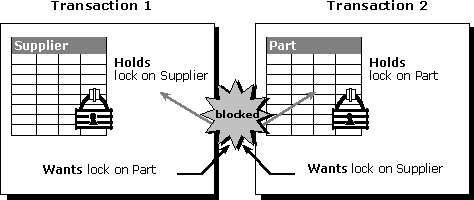Deadlocking
A deadlock occurs when there is a cyclic dependency between two or more threads for some set of resources.
Deadlock is a condition that can occur on any system with multiple threads, not just on a relational database management system. A thread in a multi-threaded system may acquire one or more resources (for example, locks). If the resource being acquired is currently owned by another thread, the first thread may have to wait for the owning thread to release the target resource. The waiting thread is said to have a dependency on the owning thread for that particular resource.
If the owning thread wants to acquire another resource that is currently owned by the waiting thread, the situation becomes a deadlock: both threads cannot release the resources they own until their transactions are committed or rolled back, and their transactions cannot be committed or rolled back because they are waiting on resources the other owns. For example, thread T1 running transaction 1 has an exclusive lock on the Supplier table. Thread T2 running transaction 2 obtains an exclusive lock on the Part table, and then wants a lock on the Supplier table. Transaction 2 cannot obtain the lock because transaction 1 has it. Transaction 2 is blocked, waiting on transaction 1. Transaction 1 then wants a lock on the Part table, but cannot obtain it because transaction 2 has it locked. The transactions cannot release the locks held until the transaction is committed or rolled back. The transactions cannot commit or roll back because they require a lock held by the other transaction to continue.
Note Deadlocking is often confused with normal blocking. When one transaction has a lock on a resource that another transaction wants, the second transaction waits for the lock to be released. By default, SQL Server transactions do not time out (unless LOCK_TIMEOUT is set). The second transaction is blocked, not deadlocked. For more information, see Customizing the Lock Time-out.

In this illustration, thread T1 has a dependency on thread T2 for the Part table lock resource. Similarly, thread T2 has a dependency on thread T1 for the Supplier table lock resource. Because these dependencies form a cycle, there is a deadlock between threads T1 and T2.